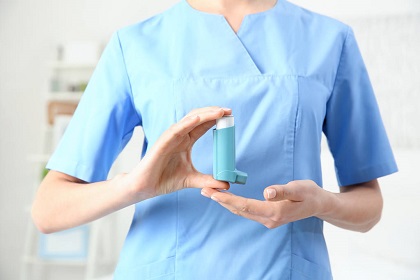Search
Related Articles

How to use Accuhaler
Step 1: Open• Hold your Accuhaler in one hand with the dose-counter
How to Use a Metered-Dose Inhaler and a Spacer
WHAT YOU NEED TO KNOW:What is a metered-dose inhaler and a spacer?A
Athletes’ Cardiorespiratory Functional Assessmen
Have you ever felt discomfort during exercise like shortness of brea
What is a bronchoscopy?
A bronchoscopy is a procedure where a tube is inserted into the lower respiratory tract via the nose or mouth. This allows your physician to clearly visualize lesions in the trachea and bronchi. The bronchoscope is equipped to take samples of tissue directly observed by your physician for biopsy, to take smears by brushing, and to perform bronchial lavage. The equipment involved allows your physician to make an accurate diagnosis and to perform treatment more easily.
The bronchoscope is a soft and flexible tube with a small diameter, enabling a clear field of vision with a high degree of safety. The patient experiences minimal discomfort and only requires a local anesthetic. Most importantly, a bronchoscopy is the best method for diagnosing bronchial lesions. It can be used to discover lesions deep within the trachea, bronchi, and lungs that are difficult to detect that would not be found using chest CT. Diagnosis and treatment can be performed without the need to perform surgery.
When does a bronchoscopy need to be performed?
A bronchoscopy is needed to diagnose disease in the following circumstances:
• Causes of chronic cough,hemoptysis or blood-stained sputum,localized wheezing or hoarseness are unknown
• Chest X-ray and/or CT suggests abnormal changes
• Evaluation before thoracic operation
• Diagnosis for laceration or rupture of the trachea or bronchi in chest trauma
• Etiological diagnosis of infectious disease of the lung or bronchi
• Management of the airways during mechanical ventilation
• Diagnosis and treatment for fistulas of the trachea or bronchi
A bronchoscopy is needed for disease treatment in the following circumstance:
• Remove foreign objects from the bronchi, clearing abnormal secretions from the trachea, such as sputum, pus, and blood clots
• Remove emboli from the bronchi and pulmonary reexpansion in the event of pulmonary atelectasis caused by embolism involving pus, sputum, or blood
• Confirm the location of bleeding for patients with hemoptysis, then attempting to stop bleeding locally.
• Perform local radiation or local injection with chemotherapy drugs for patients with lung cancer
• Guided intubation of the airways and guided bronchial intubation where there are difficulties with intubation
• Laser, microwave, frozen, or high-frequency electrosurgical treatment for patients with benign or malignant tumors of the airways
When should a bronchoscopy not be performed?
• Active massive hemoptysis
• Severe arrhythmia
• Recent myocardial infarction or history of unstable angina pectoris
• Severe heart or pulmonary dysfunction
• Thrombocytopenia, coagulation dysfunction or the other bleeding disorder.
• Newly onset cerebral infarction or hemorrhage
• Aortic aneurysm
• Incompatibility or intolerable to bronchoscopy exam
What should I pay special attention to before my bronchoscopy?
• Before the bronchoscopy do not eat or drink for 4–6 hours,sign the consent form and a family member should accompany you on the day of the procedure
• Before the bronchoscopy give an accurate account of your health condition and past medical history to your physician. Remember to also let your physician know about any drug allergies, anticoagulants orantiplatelet drugs still used, hypertrophic rhinosinusitis, snoring, throat surgery you have had done, or serious cervical vertebrae diseases you may have
• Before the bronchoscopy take medications for illnesses strictly following the schedule provided by your physician. For example, medications for hypertension or heart disease can be taken orally two hours before the bronchoscopy and will not affect the procedure
• Before the bronchoscopy complete your preoperative examination: This includes chest CT, ECG, FBC, check for infections pre-surgery, and blood coagulation studies. Before leaving home, be sure to bring any chest X-ray or CT images, ECG, FBC, and blood coagulation reports for your physician to look at
• After the bronchoscopy wait outside the examination room after your procedure for at least 30 minutes to ensure that you are not experiencing any dizziness or other symptoms before you leave the hospital
• After the bronchoscopy appearance of blood-stained sputum following bronchoscopy is normal. See your doctor immediately if there is a significant amount of hemoptysis, bloody sputum, intense chest pain, difficulty breathing, recurring fevers, or arrhythmia
• After the bronchoscopy rest well and avoid talking to reduce hoarseness and a painful throat or chest
• After the bronchoscopy do not eat or drink for 2–3 hours following the procedure. Try drinking some warm water 3 or more hours after the procedure. If you are not choking or coughing, you can eat some cool, mild food
Is a bronchoscopy dangerous?
A bronchoscopy is a relatively safe procedure. Complications may occur (such as allergies to anesthetics, laryngeal edema, cramps in the airways, hypoxia, infections, bleeding, pneumothorax, and cardiocerebral events), however the chance of them occurring is low, and your physician will actively respond if such events occur. Your physician will perform strict checks, especially before the procedure, for indications and contraindications, to ensure that you are prepared. During the procedure, your physician will perform close monitoring, and respond immediately to any symptoms, reducing the risk of complications, and ensuring that the procedure is safe and effective.
Why is fluorescence bronchoscopy necessary?
Autofluorescence bronchoscopy (AFB) is a new type of bronchoscopy procedure combining regular white light bronchoscopy (WLB) with cell autofluorescence and information technology. This equipment stimulates cell fluorescence, to determine differences in cell fluorescence. The principle behind it is that dysplasia and microinvasive carcinoma of the bronchial epithelium occurs during blue laser exposure creates a weaker red fluorescence and weaker green fluorescence compared with normal tissue. This makes lesions appear in a reddish brown color whereas normal tissue appears green. Computer-aided imaging techniques enable such lesions and their extent to be identified. AFB is unique compared with other microscopic techniques, as it allows discovery of extremely minute lesions, therefore increasing the sensitivity and accuracy of biopsies carried out via bronchoscopy.
As with regular bronchoscopies, AFB is suitable for screening and diagnosis for patients at high risk of developing lung cancer and central type lung cancer in its early stages: AFB is also suitable as a preoperative examination or follow-up examination for lung cancer, useful in determining the scope of surgery prior to a procedure, avoiding resection line involvement, and in the early discovery of relapse and local metastasis following surgery.
Reference
中华医学会呼吸病学分会:诊断性可弯曲支气管镜应用指南(2008年版)
Click the link for more information on Respiratory Medicine Clinical Service
- Previous: A Beautiful Butterfly That Keeps You Healthy
- Next: How to extract wisdom teeth? What should I pay attention to after wisdom teeth?








